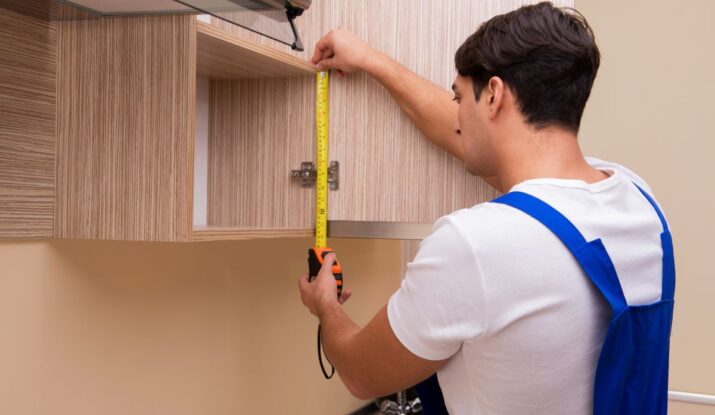You spent endless hours on kitchen design work to create the perfect setup, including finish selection and storage area planning for your pots and pans. But the cabinets you ordered end up not fitting the refrigerator while blocking the window view and turning your perfect kitchen into a puzzling mess. Frustrating, right?
Here’s the thing: Nailing the measurement of kitchen cabinets isn’t just about avoiding mishaps. It’s about creating a space that works for you, not against you. Whether you’re refreshing tired existing cabinets or starting from scratch, precise measurements are your best friend. This cabinet measurement guide strips away the guesswork, walking you through how to measure base cabinets, kitchen wall cabinets, and even those towering pantry cabinets like you’ve done it a hundred times. Ready to turn “uh-oh” into “aha”? Let’s roll.
Kitchen Cabinet Types: Roles & Standard Dimensions
Cabinets are the backbone of your kitchen, but they’re not all the same. Understanding the measurement of kitchen cabinet types is key—here’s how base, upper, and tall cabinets differ in size, function, and what to expect:
Base Cabinets
Purpose:
Hold countertops, sinks, and appliances.
Standard Base Cabinets Widths
- 12”, 18”, 24”, 30”, 36” (24” fits dishwashers; 36” suits ranges).
Standard Base Cabinets Depth:
- 24” (aligns with countertops).
Standard Base Cabinets Height:
- 34.5” (before adding countertops).
Upper Kitchen Cabinets
Purpose:
Store dishes, spices, or decorative items.
Standard Upper Cabinet Width
- 12”-36” (mix and match for flexibility).
Standard Upper Cabinet Depth:
- 12”-24” (prevents head bumps).
Standard Upper Cabinet Height:
- 12”-42” (adjust for ceiling height).
- Installation: 18” above countertops for easy access.
Tall Cabinets
- Purpose: Store brooms, pantry items, or small appliances.
- Standard Dimensions:
- Height: 84”-96” (floor-to-ceiling).
- Depth: 24”-36” (fits bulkier items).
Standard Measurement of Kitchen Cabinet Dimensions
Tools You’ll Need:
- Tape measure
- Level
- Notebook (to record measurements)
Step 1: Base Cabinets
- Width: Measure left-to-right at the top, middle, and bottom. Use the smallest number.
- Depth: Wall to cabinet front (24” standard).
- Height: Floor to cabinet top (34.5”).
Step 2: Upper Cabinets
- Height: Countertop to cabinet bottom (18” standard).
- Depth: Wall to front (12”-24”).
- Clearance: Leave 15” between upper cabinets and islands.
Step 3: Tall Cabinets
- Height: Floor-to-ceiling (subtract 1-2” for install gaps).
- Width: Measure in three spots; use the smallest number.
Golden Rule: Label every measurement (e.g., “Left base cabinet: 24” W x 24” D”).
When to Choose Standard vs. Custom Cabinets
Standard Sizes Work If:
- Your kitchen layout is straightforward.
- You’re using common appliances (24” dishwasher, 30” range).
- Ceilings are 8-9 feet tall.
Go Custom If:
- Walls are uneven or ceilings are sloped.
- You need niche features (pull-out spice racks, pet food stations).
- Appliances are non-standard (e.g., a vintage 28” oven).
Common Mistakes to Avoid When Measuring Cabinets
Let’s face it: Even seasoned DIYers slip up sometimes. Blunders in the measurement of kitchen cabinets can turn your project into a mismatched puzzle—here’s how to dodge the most common ones!
Mistake #1: Ignoring Filler Cabinets
Those skinny strips (filler cabinets) between cabinets and walls aren’t just for show. They cover gaps caused by uneven walls or gas lines. Forgetting them? Your cabinets might look awkwardly spaced—or worse, not fit at all.
Mistake #2: Assuming “Standard” Always Works
Your friend’s standard base cabinet widths might not suit your kitchen. Maybe your existing kitchen has quirks—like a sloped ceiling or a vent in the wrong spot. Always measure your space, even if you’re using standard kitchen cabinet dimensions.
Mistake #3: Forgetting About Clearances
Sure, that upper cabinet height might look good on paper, but can you actually open the doors without smacking the ceiling? Leave breathing room for hinges, cabinet doors, and your own noggin!
Mistake #4: Skipping the Double-Check
Measuring once is like proofreading an email once—you’ll miss something. Always verify your numbers. A ¼” error today could mean a new cabinet that doesn’t fit tomorrow.
Pro Tip: Snap photos of your space and jot measurements directly on them. Visuals make it easier to spot issues before they become disasters.
Maximizing Storage Space with Clever Cabinet Design
The precision of your measurement of kitchen cabinet layouts isn’t just about fitting cabinets—it’s about making every inch work smarter. Here’s how to turn your cabinets into storage superheroes:
1: Embrace Pull-Outs and Lazy Susans
- Corner cabinets: Install a lazy Susan or pull-out shelves to rescue that back corner from becoming a black hole for Tupperware.
- Base cabinets: Add pull-outs for pots and pans—no more crawling on the floor to find that missing lid!
2: Think Vertical
- Tall cabinets: Use adjustable shelves to customize for storage needs, like tall cereal boxes or small appliances.
- Upper cabinets: Stack dishes vertically with dividers to maximize storage space.
3: Use Every Nook (Yes, Even That One)
- Filler panels: Turn them into slim pull-out racks for spices or baking sheets.
- Toe kicks: Install shallow drawers under base cabinets for cookie sheets or trays.
4: Design for Your Lifestyle
- Coffee station: Dedicate a base cabinet to mugs, beans, and your brewer—keep it all in one spot.
- Kid-friendly zone: Lower wall cabinets for snacks and dishes they can grab safely.
Pro Tip: If you’re adding a kitchen island, leave at least 36 inches of walkway space around it. Crowded kitchens = chaotic cooking!
Final Thought: Taking measurement of kitchen cabinet isn’t just about numbers—it’s about creating a kitchen that flows. Nail the cabinet dimensions, avoid the pitfalls, and get creative with storage. Your dream kitchen isn’t just possible; it’s a tape measure away.
(Stuck or short on time? Dr. Cabinet offers expert measuring and installation services nationwide. Let us handle the heavy lifting—so you can focus on picking the perfect hardware!)
Optimizing Wall Cabinets, Utility Storage & Counter Space
When planning kitchen cabinetry, balancing wall cabinets installed with counter space ensures a functional and open kitchen space. Here’s how to nail the layout:
- Wall Cabinets: Stick to standard kitchen cabinet sizes (12”-24” depth) to avoid crowding your workspace. For a lighter feel, add glass inserts to upper cabinets—they keep the room airy while displaying dishes or decor.
- Utility Cabinets: These heroes accommodate brooms, small appliances, or bulk pantry items. Opt for custom-made units if your storage requirements demand deeper depths range (up to 36”) or non-standard widths.
- Counter Space: Leave sufficient space between two cabinets or appliances (at least 15”) for seamless movement.
For new kitchen cabinets, prioritize standard cabinet dimensions (24” depth for base units, 12”-24” for uppers) unless your layout needs tailored tweaks. Kitchen base cabinets with standard widths (24”, 36”) simplify appliance fitting, while custom-made designs tackle awkward corners or unique storage needs.
FAQs
What’s the standard height for upper kitchen cabinets?
Most are installed 18” above the countertop, but adjust based on your ceiling height or if you’re taller/shorter than average. Just make sure you can reach that top shelf without a step stool!
How deep should base cabinets be?
Stick to 24 inches deep—it’s the industry standard and aligns with most countertops. Deeper cabinets might eat into your walkway space.
Do I really need filler cabinets?
Yes! Those slim panels fill gaps between cabinets and walls (or appliances). Skipping them? You’ll end up with awkward spaces or doors that won’t open fully.
Can I mix cabinet sizes in my kitchen?
Absolutely! Mixing base cabinet widths (like 24” and 36”) adds visual interest. Just keep the upper cabinets aligned for a cohesive look.
How much space should I leave around a kitchen island?
Aim for 36”-42” of clearance on all sides. Any less, and it’ll feel cramped; any more, and you’ll be doing cardio to grab a spatula.
What’s the best way to measure for tall cabinets?
Measure floor-to-ceiling in multiple spots (ceilings aren’t always level!). Subtract 1-2” for installation wiggle room.
Are lazy Susans worth it for corner cabinets?
100%. They rescue that back corner from becoming a black hole for lost Tupperware. Bonus: No more crawling on your knees to find the waffle maker.
How to measure cabinets for built-in appliances like ovens or microwaves?
Review appliance specifications to get the required measurement details (including height, width and depth).
Design the installation area with 1-2 inches of empty space around the microwave for adequate ventilation while installation remains simple.
Oven cabinets need cabinet shelves that correspond precisely to the microwave dimensions.
Still stuck? Drop us a line at Dr. Cabinet—we’re here to turn your kitchen woes into “Wow, that fits perfectly!”
Conclusion
Let’s be real: Measuring kitchen cabinets isn’t exactly a thrill ride. But getting it right? That’s where the magic happens. Nail those measurement of kitchen cabinet details, and suddenly, your kitchen isn’t just functional—it’s yours. Whether you’re revamping existing cabinets or starting fresh, remember:
- Precision beats guesswork (your future self will thank you).
- Standard dimensions are helpful, but custom tweaks save the day in quirky spaces.
- Smart storage hacks (looking at you, pull-out shelves!) turn chaos into calm.
So grab that tape measure, channel your inner pro, and start plotting your dream kitchen. And hey, if you’d rather leave the heavy lifting to experts, Dr. Cabinet is here to help—with flawless installation and repair services nationwide. Because life’s too short for crooked cabinets. 😉




